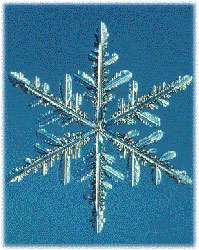|
Our main research interests are on various phase transition phenomena of snow and ice crystals. Ice is one of the most abundant materials on the earth surface, and its phase transition governs a wide variety of phenomena on the earth. For example, the growth and sublimation/melting of ice crystals give a significant impact on the earth's environment through weather and albedo of the earth surface. In addition, ice crystals play a key role in heterogeneous physical/chemical reactions, such as the degradation of ozone and organic compounds adsorbed on ice crystal surfaces by UV light irradiation, the suppression of the growth of ice in living things by antifreeze proteins adsorbed on ice crystal surfaces, etc. Hence the molecular-level understanding of ice crystals and their surfaces is crucially important.
In addition, ice can become a model system of ultra-high-temperature physics of solid. Crystals of metals and semiconductors are melted at temperatures higher than 1,000 degC. Under such high temperature, it is very difficult to study phase transition phenomena at the molecular level. However, in the case of ice, even we can touch their surfaces with our hands. Hence, ice sciences will give a clue for developing stronger buildings and faster computers.
At present, we are interested in the following subjects:
1) Mechanisms and kinetics of the growth of snow and ice crystals,
2) Quasi-liquid layers (thin liquid water layers) appearing on ice crystal surfaces below 0 degC, and
3) Ice crystals and environmental issues.
The characteristics of our studies are "cutting-edge in-situ observation" using various optical microscopy and interferometry techniques. For example, we have developed a laser confocal microscope combined with a differential interference contrast microscope (LCM-DIM). By using LCM-DIM, we can visualize individual molecular (atomic) layers with subnanometer heights directly on various crystal surfaces. We also take advantage of various interferometers, and can measure the growth of ice crystals at the nanometer level. These cutting-edge observation techniques give us the foundation of our unique studies. Hence, the further development of various in-situ observation techniques is also a part of our important research subjects.
| 
